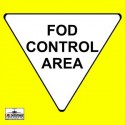Compliments of U.S. Air Force “Flying Safety” Magazine
LCDR CHRIS PLUMMER, USN
Reprinted from Approach, April 2000“Wake up. Wake up, boss. We gotta talk.” That plea came from my roommate, the MMCO (Maintenance and Material Control Officer), early one morning as we neared the end of a six-month cruise in the Persian Gulf. As I tried to shake off the previous night’s sleep, he showed me a small aspirin bottle.
I blankly stared at him and the bottle, at a total loss until he showed me a digital picture of the same aspirin bottle wedged between some cables. When I realized I was looking at flight-control cables, the horrifying perception that five of my squadronmates could have been killed hit me like a Mack truck. I was awake now.
The MMCO said that the bottle had been discovered the previous night during a Phase B inspection. Had we been skirting death on every flight since the beginning of the cruise, or had the bottle just recently found its dangerous resting place, spelling disaster for the next crew who manned this marked Hummer? Regardless, a timely maintenance inspection and an astute airframer might have prevented losing an aircrew and aircraft.
This aspirin bottle was wedged against a rudder cable in the nose of the aircraft, behind the pilot’s rudder pedals. It undoubtedly lodged there after flying forward during an arrested landing. The phase inspection also produced a metal fastener from a helmet and a small radio knob. The helmet piece and the aspirin bottle had no outstanding MAFs (Maintenance Action Form). The radio knob did.
As squadron maintenance officer, I had noticed a disturbing trend the past year, and this discovery, unfortunately, fit right in. Items brought into the aircraft by aircrew remained unaccounted for until discovered by maintenance personnel, whereas items lost by maintainers were scrupulously documented.
We have all heard the old maxim of naval aviation: FOD kills. Most of us carry things into the airplane—pens, grease pencils, nasal spray, cameras, loose change, whiz wheels, pocket knives. The list is endless. Unlike maintenance personnel, who account for everything they bring in and out of the aircraft, aviators are on a sort of honor system.
If an aviator stuffs an extra ballpoint pen into his helmet bag and forgets it, he’ll only remember it when it comes flying out of his helmet bag on an arrested landing. The Naval Aviation Maintenance Program says the FOD Prevention Program is an all-hands effort and must be supported by every person assigned to the command. Ideally, aviators and maintenance troops alike should be equally accountable to the CO with respect to FOD. In reality, however, an aviator who leaves his kneeboard in the aircraft owes some PR (Parachute Rigger) a six-pack, whereas a trooper who leaves a flash-light in the aircraft goes to mast (That’s “punishment” for us Air Force types. Ed.).
You can’t just say that aviators are above the law, because we are only hurting ourselves. We don’t own these aircraft and are putting more than just our own lives at risk. The pen unintentionally left behind could kill your best friend and orphan his family.
I briefed our safety officer and the chain of command on the incident. Hours later, the safety officer showed all the aircrew the aspirin bottle and the pictures. The ready room discussed aircrew-induced FOD. The pictures of the bottle wedged behind the rudder cable had a sobering effect. We all brought our helmet bags to the ready room and purged them of loose, non-essential items. It was an invaluable lesson learned at no cost.
(It doesn’t matter who FOD comes from. What does matter is that it’s documented in the aircraft forms and found. Remember. The life you save may be your own. Ed.)
(LCdr. Plummer flies with VAW-117.)
You Pick: Cheap Lesson or Expensive Mishap
July 26, 2000 by



